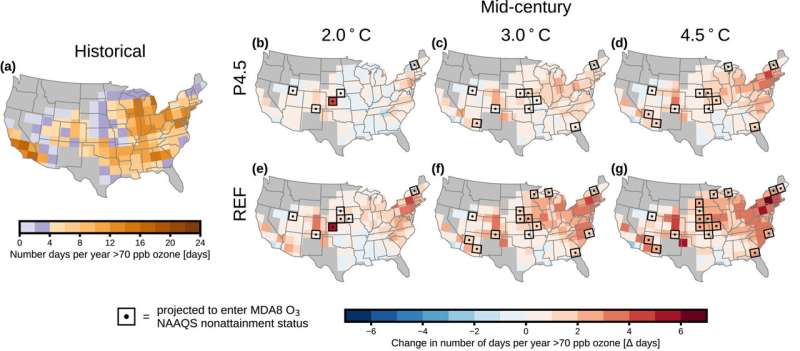This article has been reviewed according to Science X's editorial process and policies. Editors have highlighted the following attributes while ensuring the content's credibility:
fact-checked
peer-reviewed publication
trusted source
proofread
Climate change will make air pollution worse—here's how

A new study finds climate change is likely to make upward spikes of ozone at ground level worse by 2050, which could result in many parts of the United States falling out of compliance with air quality standards and increasing risks to public health.
Ozone is a reactive gas that consists of three oxygen atoms. And while it can be naturally occurring, at ground level it is often formed by the interaction of volatile organic compounds (VOCs) and nitrogen oxides (NOx)—which are both air pollutants.
"Climate change affects ozone formation through a complex set of factors, but warmer temperatures are correlated with increases to ozone in polluted areas," says James East, first author of a paper on the study published in Earth's Future. East is a former Ph.D. student at North Carolina State University who is now a researcher at Harvard University.
"That means areas that already have higher levels of air pollution of VOCs and NOx will likely see increases in ozone as average temperatures go up. What's more, climate change is expected to increase naturally occurring VOC emissions in some parts of the U.S., such as the Southeast, exacerbating the challenge."
Increases in ozone are important because ground-level ozone can cause a wide array of health problems, including decreased lung function and inflammation of airways, contributing to hundreds of thousands of deaths each year.
"It's pretty well-established that climate change will increase ozone pollution, but there has been a tremendous amount of uncertainty regarding what that increase might look like," says Fernando Garcia Menendez, corresponding author of the work and an associate professor of environmental engineering at NC State.
"Our goal with this work was to quantify the range of outcomes and get a much clearer picture of how climate change will affect ozone pollution events in the U.S."
"Atmospheric chemistry is complex, and climate change affects the rate of chemical reactions, the amount of ozone precursors present, and how long the ozone will linger in the environment," Garcia Menendez says.
"We built on a variety of existing models and incorporated statistical tools that allow us to account for this wide array of variables to look at ozone pollution in the years ahead."
Specifically, the researchers looked at how often ozone levels would exceed air quality standards designed to protect public health, how far ozone levels would overshoot the standards, and how that may change by 2050.
The study's findings are presented as a range, because climate scientists still have some uncertainty about how sensitive the climate is to changes in the concentration of greenhouse gases.
The best case scenario is that the climate has a relatively low sensitivity to carbon dioxide. If that is the case, the new study finds that the high end of ozone measurements would—on average—go up by less than 0.3 parts per billion (ppb). Those high measurements could still be below the existing air quality standards for many locations.
"However, even in this best case scenario, we found that more variability in ozone levels is projected for 2050—meaning that we'd still expect to see an increase in the number of days where there is an exceptionally high increase in ozone, violating the air quality standard," says East.
The worst case scenario is that the climate is highly sensitive to carbon dioxide. In that case the study says the high end of ozone measurements would—on average—go up by more than 2.3 ppb. Coupled with the increase in variability, this would mean that many parts of the country would see a significant increase in the number of days when ozone levels exceed air quality standards.
"In practical terms, our study finds that between 5 million and 13 million additional people will be exposed to dangerously high levels of ozone in 2050," East says.
"Right now, state and federal governments are trying to manage ozone levels by reducing emissions of air pollutants," says Garcia Menendez. "This work suggests that the current emissions reductions efforts may be less effective for helping meet ozone standards for many parts of the country, particularly those that are already struggling to meet air quality standards."
"This work is important for two reasons," East says. "First, it contributes to our understanding of how climate change will affect ground-level air quality and, by extension, human health. Among other things, this contributes to the way we estimate cost/benefit analyses of climate regulations and related technologies.
"Second, by clarifying the range of climate impacts on ozone, we're providing critical information that can inform policy decisions—such as EPA's ongoing review of the air quality standard for ozone."
More information: James D. East et al, Projecting Changes in the Frequency and Magnitude of Ozone Pollution Events Under Uncertain Climate Sensitivity, Earth's Future (2024). DOI: 10.1029/2023EF003941
Journal information: Earth's Future
Provided by North Carolina State University





















